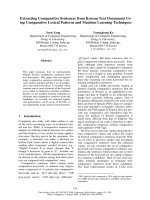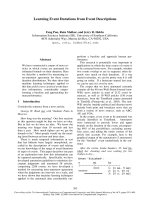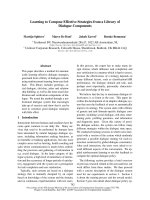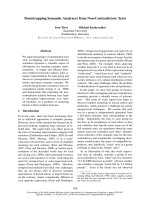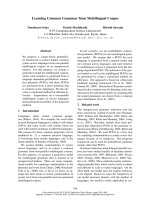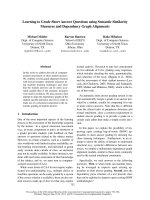Báo cáo khoa học: "Learning Semantic Categories from Clickthrough Logs" pdf
Bạn đang xem bản rút gọn của tài liệu. Xem và tải ngay bản đầy đủ của tài liệu tại đây (322.59 KB, 4 trang )
Proceedings of the ACL-IJCNLP 2009 Conference Short Papers, pages 189–192,
Suntec, Singapore, 4 August 2009.
c
2009 ACL and AFNLP
Learning Semantic Categories from Clickthrough Logs
Mamoru Komachi
Nara Institute of Science and Technology (NAIST)
8916-5 Takayama, Ikoma, Nara 630-0192, Japan
Shimpei Makimoto and Kei Uchiumi and Manabu Sassano
Yahoo Japan Corporation
Midtown Tower, 9-7-1 Akasaka, Minato-ku, Tokyo 107-6211, Japan
{smakimot,kuchiumi,msassano}@yahoo-corp.jp
Abstract
As the web grows larger, knowledge ac-
quisition from the web has gained in-
creasing attention. In this paper, we pro-
pose using web search clickthrough logs
to learn semantic categories. Experimen-
tal results show that the proposed method
greatly outperforms previous work using
only web search query logs.
1 Introduction
Compared to other text resources, search queries
more directly reflect search users’ interests (Sil-
verstein et al., 1998). Web search logs are get-
ting a lot more attention lately as a source of in-
formation for applications such as targeted adver-
tisement and query suggestion.
However, it may not be appropriate to use
queries themselves because query strings are often
too heterogeneous or inspecific to characterize the
interests of the user population. Although it is not
clear that query logs are the best source of learning
semantic categories, all the previous studies using
web search logs rely on web search query logs.
Therefore, we propose to use web search
clickthrough logs to learn semantic categories.
Joachims (2002) developed a method that utilizes
clickthrough logs for training ranking of search
engines. A search clickthrough is a link which
search users click when they see the result of
their search. The intentions of two distinct search
queries are likely to be similar, if not identical,
when they have the same clickthrough. Search
clickthrough logs are thus potentially useful for
learnin semantic categories. Clickthrough logs
have the additional advantage that they are avail-
able in abundance and can be stored at very low
cost.
1
Our proposed method employs search click-
1
As for data availability, MSN Search query logs
(RFP 2006 dataset) were provided to WSCD09: Work-
through logs to improve semantic category acqui-
sition in both precision and recall.
We cast semantic category acquisition from
search logs as the task of learning labeled in-
stances from few labeled seeds. To our knowledge
this is the first study that exploits search click-
through logs for semantic category learning.
2
2 Related Work
There are many techniques that have been devel-
oped to help elicit knowledge from query logs.
These algorithms use contextual patterns to extract
a category or a relation in order to learn a target in-
stance which belongs to the category (e.g. cat in
animal class) or a pair of words in specific relation
(e.g. headquarter to a company). In this work,
we focus on extracting named entities of the same
class to learn semantic categories.
Pas¸ca and Durme (2007) were the first to dis-
cover the importance of search query logs in nat-
ural language processing applications. They fo-
cused on learning attributes of named entities, and
thus their objective is different from ours. An-
other line of new research is to combine various re-
sources such as web documents with search query
logs (Pas¸ca and Durme, 2008; Talukdar et al.,
2008). We differ from this work in that we use
search clickthrough logs rather than search query
logs.
Komachi and Suzuki (2008) proposed a boot-
strapping algorithm called Tchai, dedicated to the
task of semantic category acquisition from search
query logs. It achieves state-of-the-art perfor-
mance for this task, but it only uses web search
query logs.
shop on Web Search Click Data 2009 participants. http://
research.microsoft.com/en-US/um/people/nickcr/WSCD09/
2
After the submission of this paper, we found that (Xu et
al., 2009) also applies search clickthrough logs to this task.
This work independently confirms the effectiveness of click-
through logs to this task using different sources.
189
Figure 1: Labels of seeds are propagated to unla-
beled nodes.
3 Quetchup
3
Algorithm
In this section, we describe an algorithm for
learning semantic categories from search logs us-
ing label propagation. We name the algorithm
Quetchup.
3.1 Semi-supervised Learning by Laplacian
Label Propagation
Graph-based semi-supervised methods such as la-
bel propagation are known to achieve high perfor-
mance with only a few seeds and have the advan-
tage of scalability.
Figure 1 illustrates the process of label propa-
gation using a seed term “singapore” to learn the
Travel domain.
This is a bipartite graph whose left-hand side
nodes are terms and right-hand side nodes are
patterns. The strength of lines indicates related-
ness between each node. The darker a node, the
more likely it belongs to the Travel domain. Start-
ing from “singapore,” the pattern “♯ airlines”
4
is
strongly related to “singapore,” and thus the label
of “singapore” will be propagated to the pattern.
On the other hand, the pattern “♯ map” is a neu-
tral pattern which co-occurs with terms other than
the Travel domain such as “google” and “yahoo.”
Since the term “china” shares two patterns, “♯ air-
lines” and “♯ map,” with “singapore,” the label of
the seed term “singapore” propagates to “china.”
“China” will then be classified in the Travel do-
main. In this way, label propagation gradually
propagates the label of seed instances to neigh-
bouring nodes, and optimal labels are given as the
3
Query Term Chunk Processor
4
♯ is the place into which a query fits.
Input:
Seed instance vector F (0)
Instance similarity matrix A
Output:
Instance score vector F (t)
1: Construct the normalized Laplacian matrix L = I −
D
−1/2
AD
−1/2
2: Iterate F (t + 1) = α(−L)F (t) + (1 − α)F (0) until
convergence
Figure 2: Laplacian label propagation algorithm
labels at which the label propagation process has
converged.
Figure 2 describes label propagation based on
the regularized Laplacian. Let a sample x
i
be x
i
∈
X , F (0) be a score vector of x comprised of a
label set y
i
∈ Y, and F (t) be a score vector of
x after step t. Instance-instance similarity matrix
A is defined as A = W
T
W where W is a row-
normalized instance-pattern matrix. The (i, j)-th
element of W
ij
contains the normalized frequency
of co-occurrence of instance x
i
and pattern p
j
. D
is a diagonal degree matrix of N where the (i, i)th
element of D is given as D
ii
=
j
N
ij
.
This algorithm in Figure 2 is similar to (Zhou
et al., 2004) except for the method of construct-
ing A and the use of graph Laplacian. Zhou et al.
proposed a heuristic to set A
ii
= 0 to avoid self-
reinforcement
5
because Gaussian kernel was used
to create A. The Laplacian label propagation does
not need such a heuristic because the graph Lapla-
cian automatically reduces self-reinforcement by
assigning negative weights to self-loops.
In the task of learning one category, scores of la-
beled (seed) instances are set to 1 whereas scores
of unlabeled instances are set to 0. The output is
a score vector which holds relatedness to seed in-
stances in descending order. In the task of learning
two categories, scores of seed instances are set to
either 1 or −1, respectively, and the final label of
instance x
i
will be determined by the sign of out-
put score vector y
i
.
Label propagation has a parameter α ∈ (0, 1]
that controls how much the labels of seeds are em-
phasized. As α approaches 0 it puts more weight
on labeled instances, while as α increases it em-
ploys both labeled and unlabeled data.
There exists a closed-form solution for Lapla-
cian label propagation:
5
Avoiding self-reinforcement is important because it
causes semantic drift, a phenomenon where frequent in-
stances and patterns unrelated to seed instances infect seman-
tic category acquisition as iteration proceeds.
190
Category Seed
Travel jal (Japan Airlines), ana (All Nippon
Airways), jr (Japan Railways), じ ゃ ら
ん (jalan: online travel guide site), his
(H.I.S.Co.,Ltd.: travel agency)
Finance みずほ銀行 (Mizuho Bank), 三井住友銀行
(Sumitomo Mitsui Banking Corporation),
jcb, 新生銀行 (Shinsei Bank), 野村證券
(Nomura Securities)
Table 1: Seed terms for each category
F
∗
=
∞
t=0
(α(−L))
t
F (0) = (I + αL)
−1
F (0)
However, the matrix inversion leads to O(n
3
)
complexity, which is far from realistic in a real-
world configuration. Nonetheless, it can be ap-
proximated by fixing the number of steps for label
propagation.
4 Experiments with Web Search Logs
We will describe experimental result comparing
a previous method Tchai to the proposed method
Quetchup with clickthrough logs (Quetchup
click
)
and with query logs (Quetchup
query
).
4.1 Experimental Settings
Search logs We used Japanese search logs col-
lected in August 2008 from Yahoo! JAPAN Web
Search. We thresholded both search query and
clickthrough logs and retained the top 1 million
distinct queries. Search logs are accompanied by
their frequencies within the logs.
Construction of an instance-pattern matrix
We used clicked links as clickthrough patterns.
Links clicked less than 200 times were removed.
After that, links which had only one co-occurring
query were pruned.
6
On the other hand, we used
two term queries as contextual patterns. For in-
stance, if one has the term “singapore” and the
query “singapore airlines,” the contextual pattern
“♯ airlines” will be created. Query patterns appear-
ing less than 100 times were discarded.
The (i, j)-th element of a row-normalized
instance-pattern matrix W is given by
W
ij
=
|x
i
,p
j
|
k
|x
i
,p
k
|
.
Target categories We used two categories,
Travel and Finance, to compare proposed methods
with (Komachi and Suzuki, 2008).
6
Pruning facilitates the computation time and reduces the
size of instance-pattern matrix drastically.
When a query was a variant of a term or con-
tains spelling mistakes, we estimated original form
and manually assigned a semantic category. We
allowed a query to have more than two categories.
When a query had more than two terms, we as-
signed a semantic category to the whole query tak-
ing each term into account.
7
System We used the same seeds presented in Ta-
ble 1 for both Tchai and Quetchup. We used the
same parameter for Tchai described in (Komachi
and Suzuki, 2008), and collected 100 instances by
iterating 10 times and extracting 10 instances per
iteration. The number of iteration of Quetchup is
set to 10. The parameter α is set to 0.0001.
Evaluation It is difficult in general to define re-
call for the task of semantic category acquisition
since the true set of instances is not known. Thus,
we evaluated all systems using precision at k and
relative recall (Pantel and Ravichandran, 2004).
8
Relative recall is the coverage of a system given
another system as baseline.
4.2 Experimental Result
4.2.1 Effectiveness of Clickthrough Logs
Figures 3 to 6 plot precision and relative recall
for three systems to show effectiveness of search
clickthrough logs in improvement of precision and
relative recall. Relative recall of Quetchup
click
and
Tchai were calculated against Quetchup
query
.
Quetchup
click
gave the best precision among
three systems, and did not degenerate going down
through the list. In addition, it was demonstrated
that Quetchup
click
gives high recall. This result
shows that search clickthrough logs effectively im-
prove both precision and recall for the task of se-
mantic category acquisition.
On the other hand, Quetchup
query
degraded in
precision as its rank increased. Manual check of
the extracted queries revealed that the most promi-
nent queries were Pornographic queries, followed
by Food, Job and Housing, which frequently ap-
pear in web search logs. Other co-occurrence met-
rics such as pointwise mutual information would
be explored in the future to suppress the effect of
frequent queries.
In addition, Quetchup
click
constantly out-
performed Tchai in both the Travel and Fi-
7
Since web search query logs contain many spelling mis-
takes, we experimented in a realistic configuration.
8
Typically, precision at k is the most important measure
since the top k highest scored terms are evaluated by hand.
191
0
0.2
0.4
0.6
0.8
1
10 20 30 40 50 60 70 80 90 100
Precision
Rank
Quetchup (click)
Quetchup (query)
Tchai
Figure 3: Precision of Travel domain
0
0.2
0.4
0.6
0.8
1
10 20 30 40 50 60 70 80 90 100
Precision
Rank
Quetchup (click)
Quetchup (query)
Tchai
Figure 4: Precision of Finance domain
0
2
4
6
8
10
10 20 30 40 50 60 70 80 90 100
Relative recall
Rank
Quetchup (click)
Tchai
Figure 5: Relative recall of Travel domain
0
2
4
6
8
10
10 20 30 40 50 60 70 80 90 100
Relative recall
Rank
Quetchup (click)
Tchai
Figure 6: Relative recall of Finance domain
nance domains in precision and outperfomed
Quetchup
query
in relative recall. The differences
between the two domains of query-based systems
seem to lie in the size of correct instances. The Fi-
nance domain is a closed set which has only a few
effective query patterns, whereas Travel domain is
an open set which has many query patterns that
match correct instances. Quetchup
click
has an ad-
ditional advantage that it is stable across over the
ranked list, because the variance of the number of
clicked links is small thanks to the nature of the
ranking algorithm of search engines.
5 Conclusion
We have proposed a method called Quetchup
to learn semantic categories from search click-
through logs using Laplacian label propagation.
The proposed method greatly outperforms previ-
ous method, taking the advantage of search click-
through logs.
Acknowledgements
The first author is partly supported by the grant-in-
aid JSPS Fellowship for Young Researchers. We
thank the anonymous reviewers for helpful com-
ments and suggestions.
References
T. Joachims. 2002. Optimizing Search Engines Using Click-
through Data. KDD, pages 133–142.
M. Komachi and H. Suzuki. 2008. Minimally Supervised
Learning of Semantic Knowledge from Query Logs. IJC-
NLP, pages 358–365.
M. Pas¸ca and B. V. Durme. 2007. What You Seek is What
You Get: Extraction of Class Attributes from Query Logs.
IJCAI-07, pages 2832–2837.
M. Pas¸ca and B. V. Durme. 2008. Weakly-Supervised Ac-
quisition of Open-Domain Classes and Class Attributes
from Web Documents and Query Logs. ACL-2008, pages
19–27.
P. Pantel and D. Ravichandran. 2004. Automatically Label-
ing Semantic Classes. HLT/NAACL-04, pages 321–328.
C. Silverstein, M. Henzinger, H. Marais, and M. Moricz.
1998. Analysis of a Very Large AltaVista Query Log. Dig-
ital SRC Technical Note 1998-014.
P. P. Talukdar, J. Reisinger, M. Pas¸ca, D. Ravichandran,
R. Bhagat, and F. Pereira. 2008. Weakly-Supervised Ac-
quisition of Labeled Class Instances using Graph Random
Walks. EMNLP-2008, pages 581–589.
G. Xu, S. Yang, and H. Li. 2009. Named Entity Mining
from Click-Through Log Using Weakly Supervised Latent
Dirichlet Allocation. KDD. to appear.
D. Zhou, O. Bousquet, T. N. Lal, J. Weston, and B. Sch¨okopf.
2004. Learning with Local and Global Consistency.
NIPS, 16:321–328.
192

